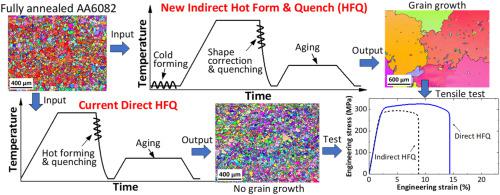International Journal of Machine Tools and Manufacture ( IF 14.0 ) Pub Date : 2023-08-29 , DOI: 10.1016/j.ijmachtools.2023.104073 Ruiqiang Zhang , Wei Wang , Jianguo Lin , Trevor A. Dean

|
The process of Hot Form and Quench of aluminum alloys, called Direct HFQ®, has been developed and applied to manufacture high-strength panel components, in which aluminum alloy sheet is heated to solution heat treatment temperature, quickly transferred to cold press dies, simultaneously formed and quenched, and subsequently artificially aged. For Direct HFQ, however, forming occurs at high temperatures, which results in high workpiece/die friction and wear, and hence high tooling and maintenance costs. In the present study, a novel Indirect HFQ for aluminum alloys has been proposed, in which alloy sheet in the O temper is formed at room temperature, then heated to solution heat treatment temperature, and quickly transferred to cold press dies for shape calibration and quenching, followed by artificial aging. In order to compare Indirect HFQ with Direct HFQ, AA6082 sheet specimens have been deformed uniaxially using the two HFQ techniques to a given strain or fracture. Mechanical properties of the deformed specimens have been measured, and differences in mechanical properties after the two HFQ processes have been quantified. Their microstructures have also been characterized to explain those differences. In addition, both HFQ techniques have been applied to form a B-pillar sectional component. It has been found that grain growth occurs in alloy deformed uniaxially to a strain higher than or equal to 10% during Indirect HFQ process, and the degree of grain growth decreases with increasing deformation. The grain growth during Indirect HFQ leads to a lower yield strength (up to ∼8%) and tensile strength (up to ∼12%) than that of the alloy processed using Direct HFQ. In addition, the alloy has a lower ductility and formability during Indirect HFQ than Direct HFQ.
中文翻译:

用于制造铝合金板部件的间接热成形和淬火 (HFQ) 以及与直接 HFQ 的比较
铝合金热成型和淬火工艺,称为 Direct HFQ®,已开发并应用于制造高强度面板组件,其中铝合金板被加热至固溶热处理温度,快速转移到冷压模具,同时成型并淬火,然后进行人工时效。然而,对于直接 HFQ,成型是在高温下进行的,这会导致工件/模具的高摩擦和磨损,从而导致高加工和维护成本。在本研究中,提出了一种用于铝合金的新型间接HFQ,其中在室温下形成O回火的合金板,然后加热到固溶热处理温度,并快速转移到冷压模具进行形状校准和淬火,其次是人工老化。为了比较间接 HFQ 与直接 HFQ,使用两种 HFQ 技术对 AA6082 板材样本进行单轴变形,以达到给定的应变或断裂。测量了变形样品的机械性能,并对两种 HFQ 工艺后机械性能的差异进行了量化。它们的微观结构也被表征来解释这些差异。此外,两种HFQ技术均已应用于B柱截面组件的制造。研究发现,在间接HFQ工艺中,单轴变形至应变大于或等于10%的合金会发生晶粒长大,并且晶粒长大程度随着变形量的增加而减小。与使用直接 HFQ 加工的合金相比,间接 HFQ 过程中的晶粒生长导致屈服强度(高达 ∼8%)和抗拉强度(高达 ∼12%)较低。此外,该合金在间接 HFQ 过程中的延展性和成形性比直接 HFQ 低。



























 京公网安备 11010802027423号
京公网安备 11010802027423号